Don’t Let Your RV Water Freeze!
How We Keep Our RV Water Hookup From Freezing!
Yes, this is an ice-covered tree behind our RV in South Carolina!
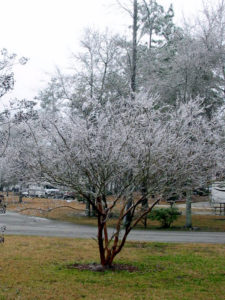 Icicles hung from the truck and the fifth wheel, and we got a bit of a snow storm. Nothing stuck to the ground, but still, we didn’t expect it. When we first decided to spend some of the winter months in the Myrtle Beach area, we didn’t think about having weather cold enough to freeze our water. But now we know better. It’s not like a New England winter, but it does happen occasionally.
Icicles hung from the truck and the fifth wheel, and we got a bit of a snow storm. Nothing stuck to the ground, but still, we didn’t expect it. When we first decided to spend some of the winter months in the Myrtle Beach area, we didn’t think about having weather cold enough to freeze our water. But now we know better. It’s not like a New England winter, but it does happen occasionally.
To make matters worse, the RV park we stay in doesn’t insulate or heat the sites’ water hydrants. They caution Rvers to unhook their water hoses if the temperature drops to 33 degrees or less. They warn you that if you don’t unhook and the hydrant freezes, you’ll be charged for any repairs. Also, until they complete repairs, you’ll have no water on your site.
You may say “WHAT? Why stay there?” Well, most nights it doesn’t get that c-c-cold. And, we really like this park! So, instead of moving further south, or doing nothing and hoping, or unhooking our hose, we decided to deal with the problem.
Here’s how we’ve been able to keep our RV water hookup from freezing for a relatively small investment of time and money.
Our Goals
- Prevent the water hydrant from freezing
- Prevent the hose from freezing between the hydrant and the fresh water port on the rig
- Be able to take a hot shower in cold weather
The Materials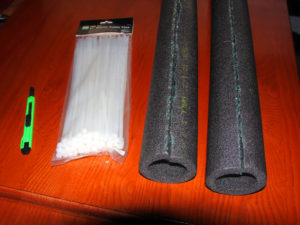
- 1½” (inside diameter) foam pipe insulation purchased at a plumbing supply store. Neither Home Depot or Lowes carried the 1½” and the vertical pipe on the hydrant is a little too large for the 1” size.
- A package of 11” cable ties for securing the insulation
- A 5 gallon plastic bucket
- Some 4” foam from an old mattress (I already had this)
- A common razor knife
How to Protect the Water Hydrant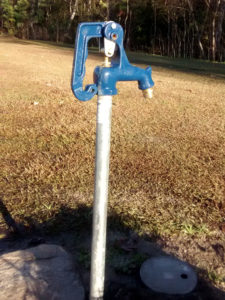
This type of water hydrant is designed not to freeze. But, this only works if your hose is unhooked from the hydrant and the water valve is turned off. Then, the water will drain down out of the stand-pipe and below the frost line.
But, we want continued access to the park’s water supply. Also, we generally haven’t seen extended periods of way-below-freezing temperatures in this South Carolina RV park. So, we’ve chosen to use insulation and a heated hose to deal with the occasional frosty nights.
- Using the pipe insulation, cover the stand-pipe and as much of
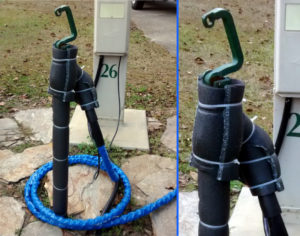 the hydrant head/valve as possible.
the hydrant head/valve as possible. - Secure the insulation around the stand-pipe and the head with the cable ties.
- I had to use overlapping pieces of the pipe insulation around the head of the hydrant, because of its size. I also ran it down over the spout to where the hose is connected, to protect that section too.
- The 5 gallon bucket insulates all of the exposed metal and keeps rain water from soaking into the top end of the pipe insulation. Cut the 4” foam into two pieces: a round piece to push down into the bottom of the bucket,
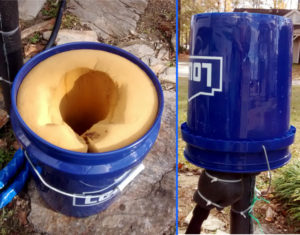 and a rectangular piece to line the sides. Then shove the bucket down over the top of the hydrant and secure it using a piece of twist-tie.
and a rectangular piece to line the sides. Then shove the bucket down over the top of the hydrant and secure it using a piece of twist-tie.
The Heated Hose & Hookup to the Camper
On the recommendation of a friend, we purchased a 25 ft. Freeze Ban heated hose from Camping World. They also come in 12 ft. and 50 ft. lengths, but we’ve found that 25 ft. is good in most cases. CAMCO, The manufacturer, states that it will protect against freezing down to 20 degrees below zero. 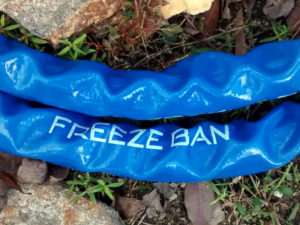 Call me a skeptic, but if it ever gets that cold, I probably will unhook!
Call me a skeptic, but if it ever gets that cold, I probably will unhook!
This hose plugs into a 120 volt outlet. It comes with a male/female hose adapter so you can attach the end with the electrical cord and thermostat either to the hydrant, or to the camper. On our site, we attach that end to the hydrant and plug it into the site’s near-by electrical box. The hose’s thermostat must be exposed to outside air in order to turn on the heating element as needed (when temperature gets down to around 37 degrees).
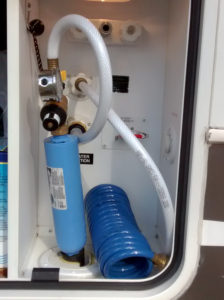 At the camper, the hose runs up into a compartment containing the rig’s fresh water connector. The compartment is heated so, as you can see in the picture, we connect the water filter and a pressure regulator/gauge on that end too.
At the camper, the hose runs up into a compartment containing the rig’s fresh water connector. The compartment is heated so, as you can see in the picture, we connect the water filter and a pressure regulator/gauge on that end too.
One night, a couple of years ago, the temperature was predicted to get down into the very low teens, or possibly single digits. To be on the safe side, I hung an old-fashioned drop light (work light), with a 60 watt incandescent bulb, in the water compartment of our RV. This provides a little extra warmth around the filter and fittings. I was careful to place it where the hot bulb wasn’t touching the hose or any of the fittings.
Wrapping It Up
First, a bit of a disclaimer: What I’m describing here is based solely on our experience and what has worked for us for the last three years. Please note, however, that we’re not dealing with really extreme cold. Our methods may not be best for your situation. If you’re facing freezing temperatures, please use your own judgment about unhooking from park water and other methods of protecting your water system. Check with the park, and with others who spend winter months in your location to see what is working for them.
The hydrant – I find the standard foam pipe insulation easy to handle and install, and it seems to work well. Other methods I’ve seen being used:
- Electric heat tape (with and without insulating over the heat tape) – this makes a lot of sense if it gets really cold
- Fiberglass pipe insulation (have to be careful to tape or cover it so the fiberglass doesn’t get wet and freeze)
- Bubble wrap (really?)
- Wrapping with a blanket or towel (hopefully covered with a trash bag or other plastic so the cloth doesn’t get wet and freeze)
The hose – I feel pretty comfortable with the heated hose, but other Rvers protect their water hoses in different ways:
- Standard (unheated) hose covered with pipe insulation
- Wrapping the hose with electric heat tape (with and without further insulation)
- Unhook, drain, and leave outside, or even bring the drained hose inside
A note of interest – I happened to notice that the Freeze Ban hose looks identical to TASTEPure heated hoses available on Amazon and other places. Even the descriptions of the product features are the same. Curious, I contacted CAMCO and they told me they are identical. It seems that Freeze Ban is the name assigned to the hoses stocked and sold by Camping World. Sort of like a “house brand.” When the same hoses are handled by other sellers, they are named TASTEPure. Same CAMCO hoses, different names. Go figure!
There are, of course, other brands of heated hoses. I’ve included links to a couple of them on Amazon so you can, if you’re interested, check out sizes, prices, and reviews. If you do decide to order one via one of our links, you won’t pay any more, but we’ll make a small commission.
TASTEPure Heated Hose
Pirit Heated Hose
TASTEPure Water Filters
We’d love to hear how you have protected your RV water from freezing. What methods have worked for you … or have not? We RVers learn a lot from each other, and we’d welcome your input. You just might help save one of us from a disaster!

That’s cool that you can get a hose that is heated so they won’t freeze during the winter. That would be super useful for staying in an RV during the winter so you don’t have to melt snow for water. That would make camping much more convenient.
Well Tyler, I sure agree with your thoughts about the usefulness of heated hoses for RVers. I see from your website that your company produces specialty heated hoses for industrial, construction, and medical requirements. Guess I never thought much about it, but I can see where your products fill very significant needs. Gotta say though, I hope I never have to pay $2,000 – $3,000+ for a heated hose to keep my RV water from freezing! Thanks for your comments.
We are full timers working in Ohio the past four winters, usually about 3 months of frigid weather. Our 25 ft heated hose only cost us about $85. Works great along with the box for the water source my husband made out of insulating boards.
This is our very first RV trailer
It’s a 5th wheel
And it gets cold since we live in Missouri up north
All I can say is…brrrrrrr! Best of luck.